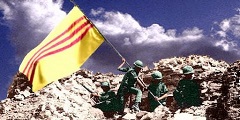source:
http://worldnews.nbcnews.com/_news/2...china-sea?lite
US, Chinese warships narrowly avoid collision in South China Sea
By David Alexander, Reuters
A U.S. guided missile cruiser operating in international waters in the South China Sea was forced to take evasive action last week to avoid a collision with a Chinese warship maneuvering nearby, the U.S. Pacific Fleet said in a statement on Friday.
The incident came as the USS Cowpens was operating in the vicinity of China's only aircraft carrier, the Liaoning, at a time of heightened tensions in the region following Beijing's declaration of an Air Defense Identification Zone farther north in the East China Sea, a U.S. defense official said.
Another Chinese warship maneuvered near the Cowpens in the incident on December 5, and the Cowpens was forced to take evasive action to avoid a collision, the Pacific Fleet said in its statement.
"Eventually, effective bridge-to-bridge communications occurred between the U.S. and Chinese crews, and both vessels maneuvered to ensure safe passage," a defense official, speaking on condition of anonymity, said in an email.
--------------------------------------------------------------------------------
The Cowpens had been in the Philippines helping with disaster relief in the aftermath of the massive typhoon that hit the region in November. The U.S. Navy said it was conducting regular freedom-of-navigation operations in the South China Sea when the incident occurred.

Getty Images
USS Cowpens (CG 63), arrives on Aug. 20, 2004 in Shizuoka, Japan.
China deployed the Liaoning to the South China Sea for maneuvers in the midst of the tensions over the air zone, which covers air space around a group of tiny islands in the East China Sea that are administered by Japan but claimed by Beijing as well.
Beijing declared the air zone late last month and demanded that aircraft flying through it provide flight plans and other information. The United States and its allies rejected the Chinese demand and have continued to fly military aircraft into the zone.
Beijing claims most of the South China Sea and is involved in territorial disputes with several of its neighbors in that region as well.
Asked if the Chinese vessel was moving toward the Cowpens with aggressive intent, an official declined to speculate on the motivations of the Chinese crew.
"U.S. leaders have been clear about our commitment to develop a stable and continuous military-to-military relationship with China," the official said in the email.
"Whether it is a tactical at-sea encounter, or strategic dialogue, sustained and reliable communication mitigates the risk of mishaps, which is in the interest of both the U.S. and China," the email said.
The Pacific Fleet said the incident with the Cowpens underscored the need for the "highest standards of professional seamanship, including communications between vessels, to mitigate the risk of an unintended incident or mishap."
"It is not uncommon for navies to operate in close proximity, which is why it is paramount that all navies follow international standards for maritime rules," the defense official said in the statement.



 Reply With Quote
Reply With Quote



 ).
).

Bookmarks